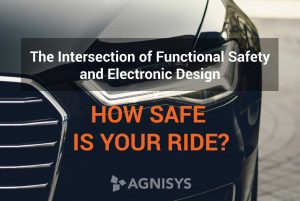 The Intersection of Functional Safety and Electronic Design
The Intersection of Functional Safety and Electronic Design
In an industry that has gone through an incredibly rapid transformation over the past few years alone, auto manufacturers all over the world have had to rethink nearly every aspect of their own processes within the context of the 21st century. Because of this, an almost incredible emphasis has been placed on what concepts like “functional safety” even mean in 2018 (or 2019, or 2020 and beyond). This is especially true as vehicles incorporate more and more electronics with each passing day.
Autonomous vehicles have elevated this concern to the next level because as the level of control that a driver has over their car goes down, the liability of that car’s manufacturer shoots sky high. Many studies have shown that when automated systems are introduced into an industry, there is often a significant increase in the rate of “adverse” events as a result. This is the point that we have currently reached in terms of self-driving cars and functional safety.
In an effort to mitigate this risk as much as possible, functional safety is necessary – but in a way that also addresses the needs of what is already a high-volume, cost-sensitive industry. Luckily, the tools to address this problem sooner rather than later are already here. They just require us to keep a few key things in mind.
Functional Safety in Automotive Electronics: Breaking It Down
One of the most important elements of functional safety as it relates to the embedded systems that are now present in modern day vehicles has to do with fault detection. Simply put, regardless of where a particular fault comes from, the system’s ability to both A) identify it, and B) resolve it in the minimum time span possible is and will always be the goal.
In a lot of ways, this requires functional safety to take a more proactive approach to its own objective than ever before. Especially in an era of self-driving and autonomous vehicles where drivers are relinquishing more control all the time, the system itself must become aware of that fault and, if possible, recover from it, all without either endangering the passengers or requiring any intervention on their behalf, to begin with.







